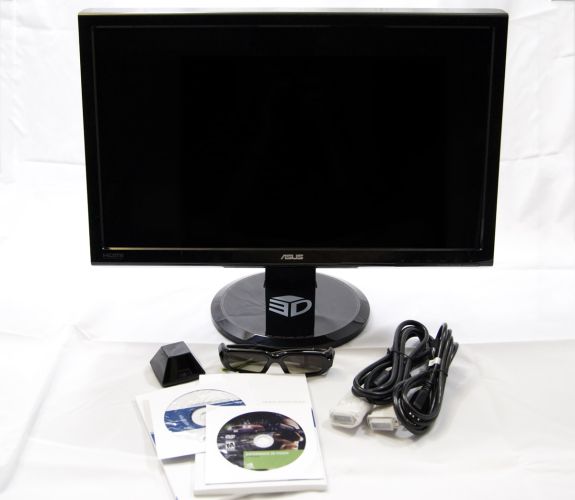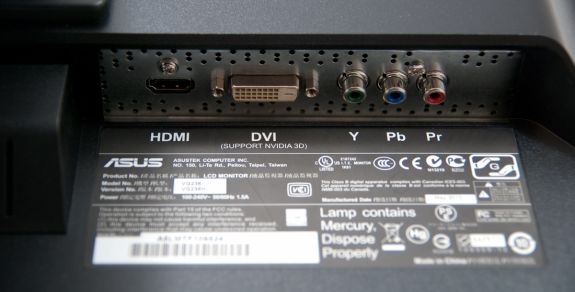ASUS VG236H 23-inch 3D Display Review: 120Hz is the Future
by Brian Klug on August 7, 2010 2:48 AM ESTOverview and Specifications
First off, let’s get the name down for this 23 inch, 120Hz display, because ASUS is selling the VG236 in two different packages and model numbers. One is the VG236H, which comes with a NVIDIA 3D Vision Kit and retails for $499. The other is the VG246HE, which is the exact same display, but comes without a bundled NVIDIA 3D Vision Kit and retails for $349. Both of those packages contain the exact same display, but just differ in whether they include the shutter glasses you’ll need to do stereoscopic 3D.
ASUS is basically selling you the 3D Vision Kit for $150, which is a pretty sweet deal. As of this writing, the same NVIDIA 3D Vision Kit is retailing on Newegg for $174.
The VG236H packs HDMI, DVI-D, and component video inputs, though the only one that will work with 120Hz refresh rates, and thus 3D, is DVI-D.
The VG236H display is glossy, as is nearly all of the bezel. ASUS claims to have added an antireflection coating to the display, as they well should. It no doubt mitigates the reflection a bit, but there’s still going to be unavoidable glare, especially if you have lights behind you. That might be killer for some, but it isn't a huge issue - I still wish it was matte though. The VG236H is also a TN panel, partly out of necessity to drive that super fast refresh rate, however color quality is actually pretty good as we’ll show in a minute. ASUS is using a technology called Dual Side driving to get to 120Hz.
Hate it or love it, the VG236H is also 16:9, and thus native 1920x1080. Finding 16:10 1920x1200 monitors which used to be the norm, not the exception, is increasingly difficult. Honestly, I’d rather have my extra 120 pixels of image height when hunting down people in games than deal with two black bars when playing back anamorphic video content. Oh well, 1080P is more marketable I guess.
Let’s go into the rest of the specifications:
| ASUS VG236H - Specifications | |||
| Property | Quoted Specification | ||
| Video Inputs | DVI-D (120 Hz 3D), HDMI, Component YPbPr | ||
| Panel Type | TN (with Dual Side driving), CCFL backlight | ||
| Pixel Pitch | 0.265 mm | ||
| Colors | 16.7 Million (24 bit) | ||
| Brightness | 400 nits maximum | ||
| Contrast Ratio | 1,000:1 (standard), or 100,000:1 (dynamic) | ||
| Response Time | 2ms (g2g) with Overdive/"Trace Free" control | ||
| Viewable Size | 23" (54.8 cm) diagonal | ||
| Resolution | 1920x1080 at 120Hz (1080P) | ||
| Viewing Angle | 170 degrees horizontal, 160 degrees vertical | ||
| Power Consumption (operation) | <60 watts typical | ||
| Power Consumption (standby) | <2 watts typical | ||
| Screen Treatment | Glossy (with antireflection coating) | ||
| Height-Adjustable | Yes: ~4" (100 mm) of travel | ||
| Tilt | Yes: -5 degrees to 15 degrees | ||
| Pivot | No | ||
| Swivel | Yes: +/- 150 degrees | ||
| VESA Wall Mounting | Yes - 100x100mm | ||
| Dimensions w/ Base (WxHxD) | 21.7" (550 mm) x 16.5" (420 mm) x 9.8" (250 mm) | ||
| Weight w/o Stand | 15.4 lbs (7.0 kg) | ||
| Additional Features | NVIDIA 3D Vision Kit, 120 Hz operation | ||
| Limited Warranty | 3 years - repair or replacement | ||
| Accessories | DVI-D cable, power cable, quick start guide, manual, warranty card, support CD, NVIDIA 3D Demo DVD, NVIDIA 3D vision kit | ||
| Price |
VG236H (includes 3D vision kit): $499 VG236HE (w/o 3D kit): $349 |
||
ASUS definitely understands its gamer segment, as including component and HDMI video inputs is definitely an added plus for people who want to hook up a game console or two. Of course, the caveat with HDMI on a display like this is that there’s no audio out for connecting headsets, something which would definitely put this over the top for most gamers. We could get upset about DisplayPort being absent, but honestly it isn’t that big of a deal, yet.












121 Comments
View All Comments
ganeshts - Saturday, August 7, 2010 - link
Is there any monitor that supports HDMI 1.4a (and thus, 3D over HDMI)?With the upcoming HDMI 1.4 GPUs, I just wish we had a monitor capable of acting as a sink for those signals instead of having to hunt down a 3D TV to test it out!
softdrinkviking - Saturday, August 7, 2010 - link
two other 120hz computer monitors i can find online...http://accessories.us.dell.com/sna/products/Displa...
i can't, for the life of me, figure out what revision of the HDMI standard it uses. alienware does not report those details, and dell offers no manual for this monitor in their support page. someone would have to call them and ask, but i live outside the US.
and an acer model...
http://us.acer.com/acer/product.do?link=oln85e.red...
this product sheet has a maximum reported 75hz over HDMI, so I am going to say "NO," not 1.4a, but it doesn't actually say that.
therealnickdanger - Sunday, August 8, 2010 - link
If 3-D game technology works the same as 3-D Blu-Ray, then it's really only 60Hz x2 (alternating per eye). It may be capable of 120Hz natively, it may display 120Hz from 2-D, but for 3-D I'm pretty sure you're still only getting 60Hz per eye.What strikes me most about this whole 120Hz topic is that I had a Sony CRT that could handle 1280x1024 @ 240Hz about 10 years ago. And yes, VSYNC @ 240Hz is why the LCD boom disappointed me so much. LCDs, while thin and light, were a horrible step backward for gaming - at least for those of us who were used to high framerates and refresh rates.
LCDs still have such catching up to do...
softdrinkviking - Tuesday, August 10, 2010 - link
you'll get no argument from me about lcds vs crts.but that's the way the industry has gone, oh well.
in any case, the acer monitor specs the HDMI 70Hz, and a different refresh rate of 120Hz for using DVI.
I believe that HDMI 1.4a is capable of delivering more than 70Hz, so I was attempting to answer that question, not to determine whether or not it is capable of playing 3D over HDMI. However, ganesh seems to think so, and I was giving him the benefit of the doubt there.
As to the second question, is there a someone who can say with authority that 3D can (or cannot) play over HDMI with a limit of a 70Hz refresh rate?
softdrinkviking - Wednesday, August 11, 2010 - link
http://www.nvidia.com/object/3d-vision-requirement...this nvidia 3d vision compatibility chart is interesting.
looks like 120Hz refresh is definitely a necessity for 3D.
Sabresiberian - Friday, August 13, 2010 - link
It clearly states in the article that the 3D effect is 60Hz each eye. Brian's comments lead me to believe it is a true 120Hz display in 2D, but I can't say that's a fact.I have to agree about the refresh rate - and it's one reason why I run a Sony FW900 CRT. I run it @ 85Hz, 1920x1200. 60 Hz is a poor standard to settle for, in my opinion. I know we all live with 60Hz flashes in our modern lives and think nothing of it, we are conditioned to our lighting doing that, but it makes a difference. 100 Hz should be the standard we build to, not 60.
I was excited about this monitor at first, but .265 dot pitch and 1920x1080 aren't what I want. .265 is better than the LCD I have, but not much, and I prefer the 16:10 over 16:9 ratio.
;)
xef6 - Wednesday, October 19, 2011 - link
I know this is an old comment, but I can confirm that it is indeed a 120hz 2D display. I haven't used it for 3D stuff yet. I just use it as a 120hz display and enjoy a much smoother interface. ATI config reports its maximum refresh rate as 120.Luke212 - Sunday, August 22, 2010 - link
hate to tell you but the highest ever Sony at that 1024 would have been 126HzCushgod - Wednesday, December 8, 2010 - link
I 240% agree with you!! :P LCD's do have catching up to do ... its sad we are coming back to the Hz I used to enjoy. I am currently on an asus-vg236h, and I am thrilled to play all my games with better framerate, and clear and smotth scrolling left and right turning, awesome BF BC2, Warhammer, and Global Agenda look beautiful. Its night and day to me. Night and Day.Fleeb - Saturday, August 7, 2010 - link
Why HDMI for monitors when DisplayPort can do the job?